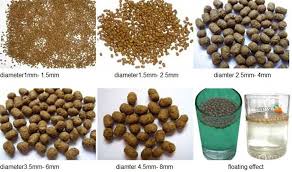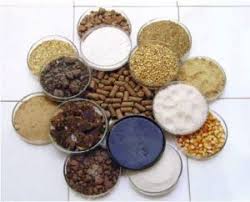The composition of the feed changes according to the nutritional needs of the fish: when it is a larva, it requires a high protein level, since it needs this resource for growth of its muscle tissue. Lipids (fats) are used by fish as their main energy source and, as they get bigger and more
active, the lipid content is increased and the protein content reduced.
Prepared or artificial fish feed may be either complete or supplemental. Complete diets supply all the ingredients (protein, carbohydrates, fats, vitamins and minerals) necessary for optimal growth and health of the fish.
When fish are reared in high density indoor systems or confined in cages and cannot forage freely on natural feeds existing in pond, they must be provided with a complete diet. In contrast, supplemental (incomplete/partial) diets are intended only to help support the natural food (insect and insect larva, algae, small fish and other benthic organisms) normally available to fish in ponds or outdoor raceways.
Supplemental diets do not contain a full complement of vitamins or minerals, but are used to help fortify the naturally available diet with extra protein, carbohydrate and / or lipid.

Fish, especially when reared in high densities, require a high-quality, nutritionally complete, balanced diet to grow rapidly and remain healthy.
Already prepared feed are pelleted to enhance better utilization by fish but the size of feeds varies simply because each size corresponds to the different stages of development and also to the physiology of the fish.
To get a well-fed fish, pellets are adapted to the development of its mouth size, which varies according to its age and the species. Imported dry feed exists from crumble-size (0.08 mm diameter) to big pellets (20 mm diameter) with several other sizes within the range.
Bagged feeds should be kept out of direct sunlight and as cool as possible. Vitamins, proteins, and lipid are especially heat sensitive, and are readily denatured by high storage temperatures. High moisture stimulates mold growth and feed decomposition. Avoid unnecessary handling and damage to feed bags which may break the pellets and create fines ¾ which may not be consumed by fish.
Read Also: Nutritional Requirements of Fishes for Optimum Performance
Read Also: Joe’s Recycling Revolution

